ARTSHOP: Fluorescent Prints | "Thermal Expansion" Paintings | Toutenfluo Art | Gallery Prints | Museum Prints | Toutenfluo Prints |
CD-Roms | Ordering Information


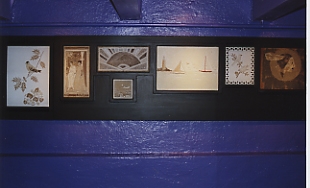
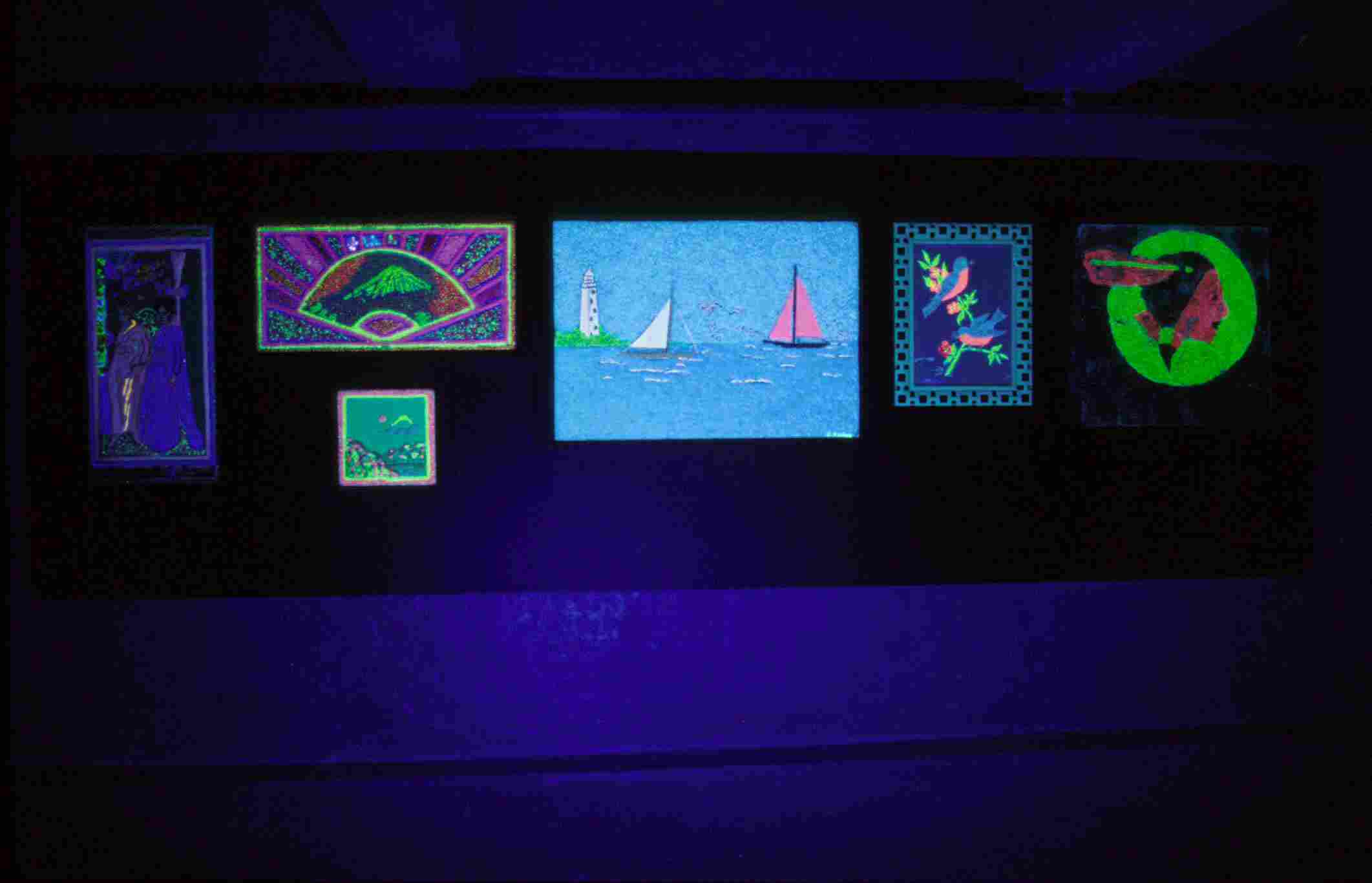
Fluorescent Mineral Artwork
- "Electric Ladyland" - White light (left)
/ Longwave and Shortwave U.V. (right)
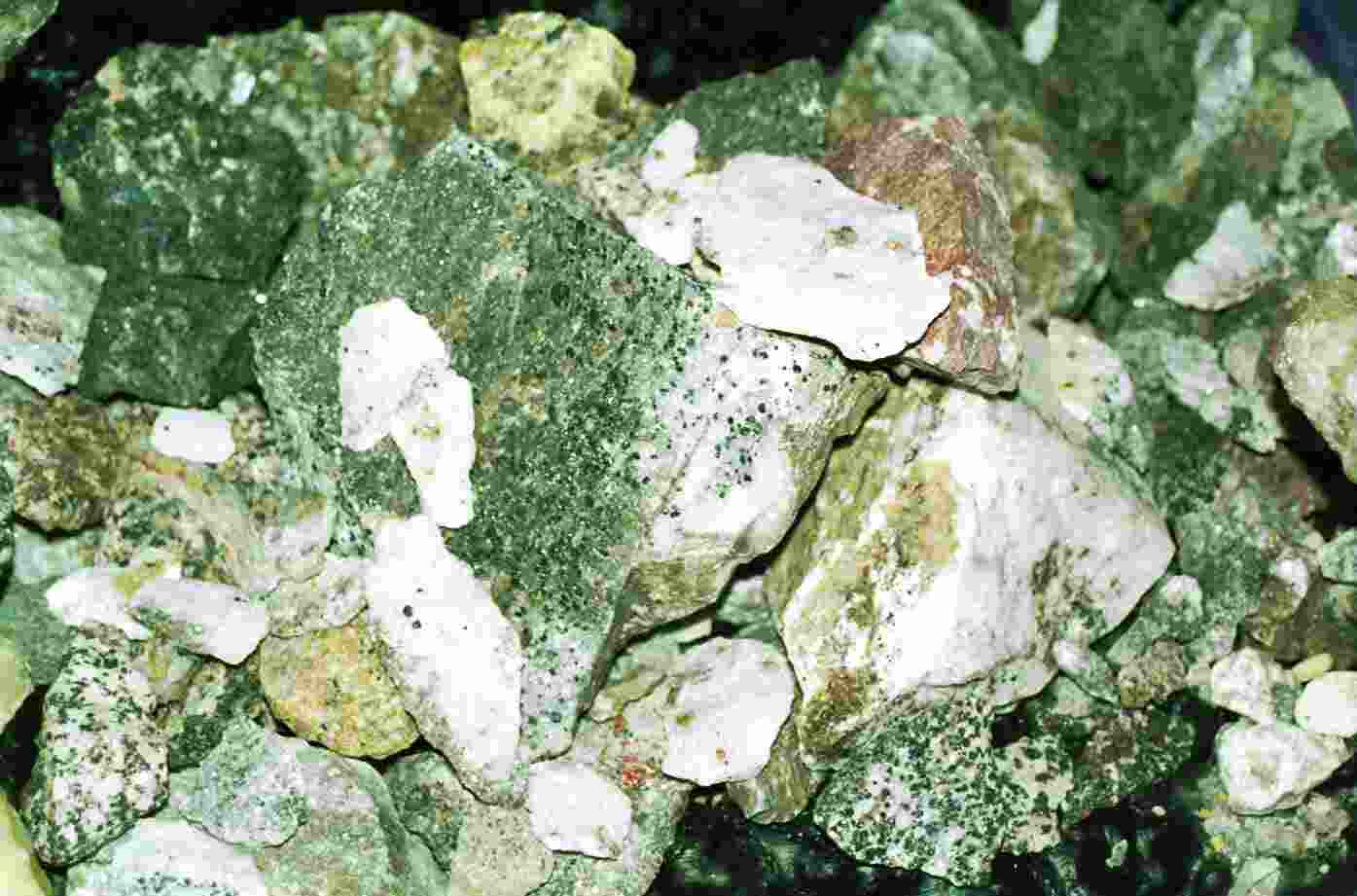

Fluorescent Minerals -
Franklin, New Jersey - White light (left) / Shortwave
U.V. (right)
"ELECTRIC LADYLAND - the First Museum of Fluorescent Art"
FLUORESCENT MINERAL ARTWORK
As seen on previous pages of this
website, and in the two photographs above, there are some minerals (about
fifteen percent)
that are capable of emitting vivid
colors when put under an Ultraviolet lamp. These minerals are usually
very common,
colorless gray stones in the daylight,
so the appearance of brilliant colors from these gray stones under the
Ultraviolet lamp
is quite dramatic. This amazing
phenomenon occurs through an atomic movement called "Electron Displacement."
Invisible Ultraviolet energy enters
certain atoms of these gray minerals, causes electrons to move to higher
orbits,
and upon their return to their
normal orbits, Visible Light - Colors - are given off by the minerals themselves.
In the 1950's a woman and her husband
created some very early pieces of Art that applied this phenomenon of Fluorescence
in Minerals. Mr. and Mrs.
Phillips lived in South Plainfield, New Jersey on top of a mountain, and
were collectors of
Fluorescent Minerals from Franklin,
New Jersey, "The Fluorescent Mineral Capital of the World."
They had the idea to use the fascinating
phenomenon of these Fluorescent Minerals to do something creative,
not just looking at these rocks,
but to make simple pieces of Art with them. Mr. Phillips crushed
the Fluorescent
Minerals, and then in the dark,
under Longwave and Shortwave Ultraviolet lamps, he tweezer-separated the
Willemite from Franklin into twenty
shades of Green, and the Calcite into twelve shades of Orange/Red.
Mr. and Mrs. Phillips also used
other Fluorescent Minerals besides Calcite and Willemite, like Scapolite
from Canada,
Microcline and tiny amounts of
rare Esperite, also both from Franklin, New Jersey.
To make the actual pieces of Art,
Mrs. Phillips first made pencil-outline drawings on canvas-board.
She then put
common household "Elmer's Glue"
on the area of the drawing she wanted color, and finally applied the crushed
Fluorescent Minerals to the glued
area. This was most likely done in the dark under separate Longwave
and Shortwave
Ultraviolet lamps. Mr. and
Mrs. Phillips were retired when they made this very early Fluorescent Mineral
Artwork
in the 1950's. Mr. Gerstmann,
of the former "Gerstmann Museum" in Franklin, New Jersey, told me,
"They did hundreds of small paintings"
- "They used to give them away." Before the "Gerstmann Museum" closed,
the masterpiece of Mrs. E. Phillips,
"Peacocks," was on display. "Peacocks" is a large Fluorescent Mineral
Artwork
about a yard (meter) across, with
two large Peacocks in a detailed landscape that took almost six months
to make.
In the "Electric Ladyland - the
First Museum of Fluorescent Art" collection three of the ten pieces of
Fluorescent Mineral Artwork on
display are by Mr. and Mrs. Phillips. In one of the most fascinating
Demonstrations
in the Museum, Mrs. E. Phillips'
"Boats at Sea" is seen as three different pictures. Under the Longwave
U.V. lamp
the seascape is a Day scene, but
when you turn on just the Shortwave U.V. lamp, the same Day scene turns
into
a Night scene. Finally, when
the seascape is seen under both the Longwave and Shortwave U.V. lamps,
the way
that all these Fluorescent Mineral
Artworks were intended to be seen, the full picture bursts
into brilliant colors.
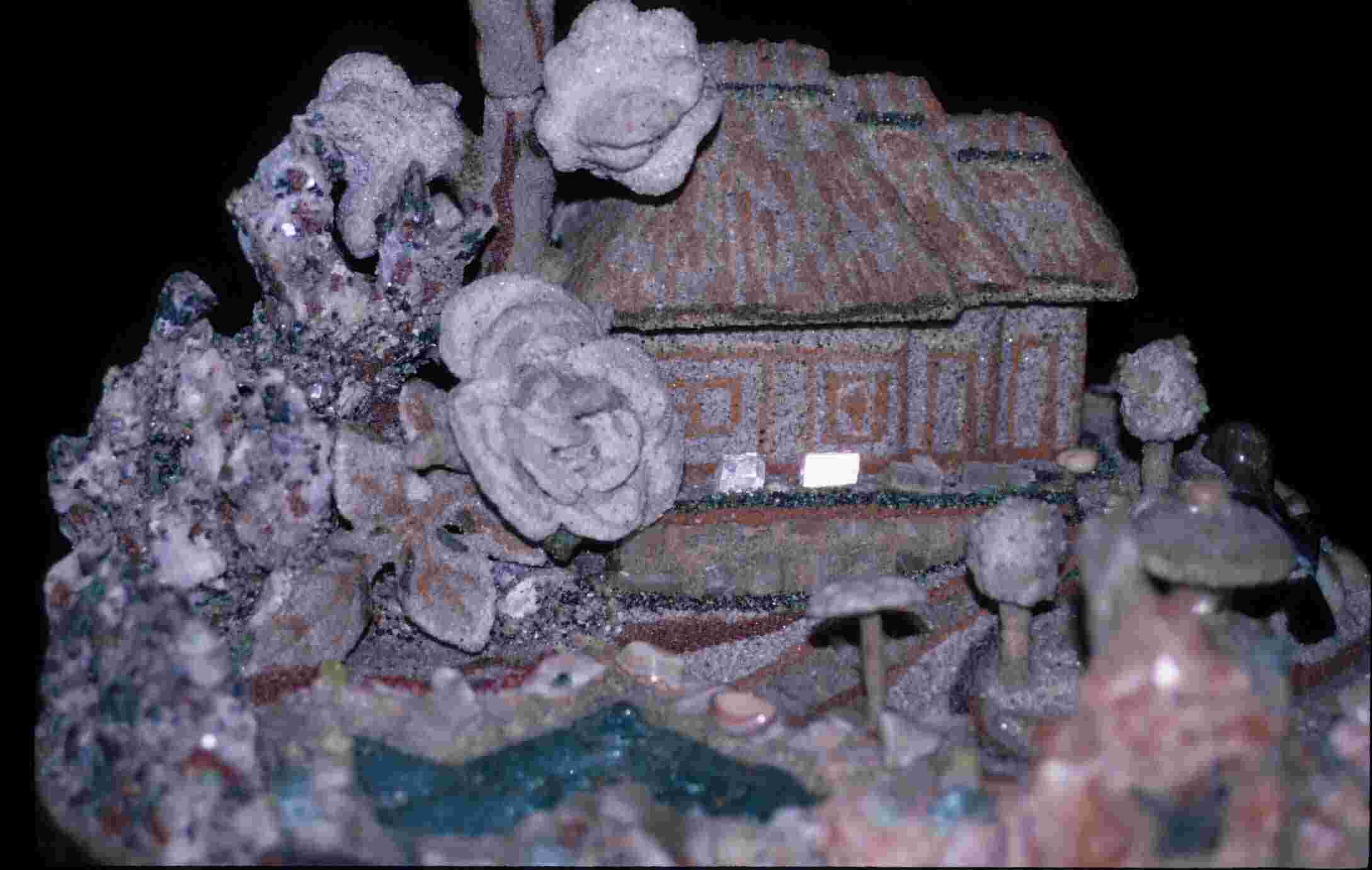

'Masterpiece' - Miera, 1950's - Fluorescent Mineral Artwork - White light (left) / Ultraviolet lamps (right)
Miera, "the Japanese Man," is the
other person who made these Fluorescent Mineral Artworks in northern New
Jersey
in the 1950's. The first
photograph above on this webpage, is the Fluorescent Mineral Artwork Masterpiece
by Miera.
Very few details are known about
this man, in fact, in New Jersey they didn't even know his name, but referred
to him as simply "the Japanese
Man." Fortunately, he signed three of the six Fluorescent Mineral
Artworks he made
in the "Electric Ladyland - the
First Museum of Fluorescent Art" collection, and several different Japanese
Museum visitors could translate
his signature as "Miera." He was supposed to have worked on these
Fluorescent
Mineral Artworks around the same
general time as Mr. and Mrs. Phillips, in the 1950's. His style of
Artwork is much
more professional than the few
other persons working in this obscure media, in drawing, design, and execution.
There are many combinations of
Fluorescent Minerals that he used to achieve a wider variety of colors
than the few
other 'Fluorescent Mineral Artists.'
Many layers of glue and Fluorescent Minerals were applied on top of each
other
to realize a slight three-dimensional
appearance to the pieces and also very vivid, concentrated colors.
Miera's Masterpiece is in the "Electric
Ladyland - the First Museum of Fluorescent Art" collection, and is seen
the last of the ten Fluorescent
Mineral Artworks in the Museum. This is a piece of Art that is hard
to believe.
It is a three-dimensional sculpture
of a house and garden about a foot (30 cm.) across, and almost that high,
completely made out of crushed
and tweezer-separated Fluorescent Minerals fifty years ago. Miera
worked on
his 'Masterpiece' for six months
and it is supposed to be his final piece of Art, according to Mr. Richard
Hauck
of the "Sterling Hill Mining Museum"
in Ogdensburg, New Jersey. One of the ten Fluorescent Mineral Artworks
in the "Electric Ladyland - the
First Museum of Fluorescent Art" collection is by neither Mrs. Phillips
or Miera,
but by one of the Miners who used
to work in the mines of New Jersey. There were mines in northern
New Jersey
from the 1850's up until 1986,
when the last operating mine in New Jersey "Sterling Hill Mine" closed
and was
turned into a Museum by Mr. Hauck.
Willemite, containing about forty-three percent Zinc, the bright
Green Fluorescent Mineral in all
these Fluorescent Mineral Artworks is the mineral that was being mined
for in New Jersey.
I know of one other person who
made Fluorescent Mineral Artwork. She signed her Artwork with the
name
"Colet" and made Fluorescent Mineral
Artwork on the West Coast in California in the 1960's or 1970's.
Of the six Fluorescent Mineral
Artworks by Colet I've seen, she used much larger fragments of Fluorescent
Minerals than Mrs. Phillips
or Miera in her pieces. All six of he Fluorescent Mineral Artworks
were fairly small,
all flowers, and had delicate wooden
frames. She also had a different method of working than Mrs. Phillips
or Miera,
by using printed magazine photos
of flowers as a base onto which she glued the particles of Fluorescent
Minerals.
The terribly irony of these Fluorescent
Mineral Artworks is that after Mr. and Mrs. Phillips and Miera died,
sometimes in the 1970's, most of
the Fluorescent Mineral Artworks they had made were thrown in the garbage(!)
because without using Longwave
and Shortwave Ultraviolet lamps, these brilliant Fluorescent Mineral Artworks
are, unfortunately, colorless.
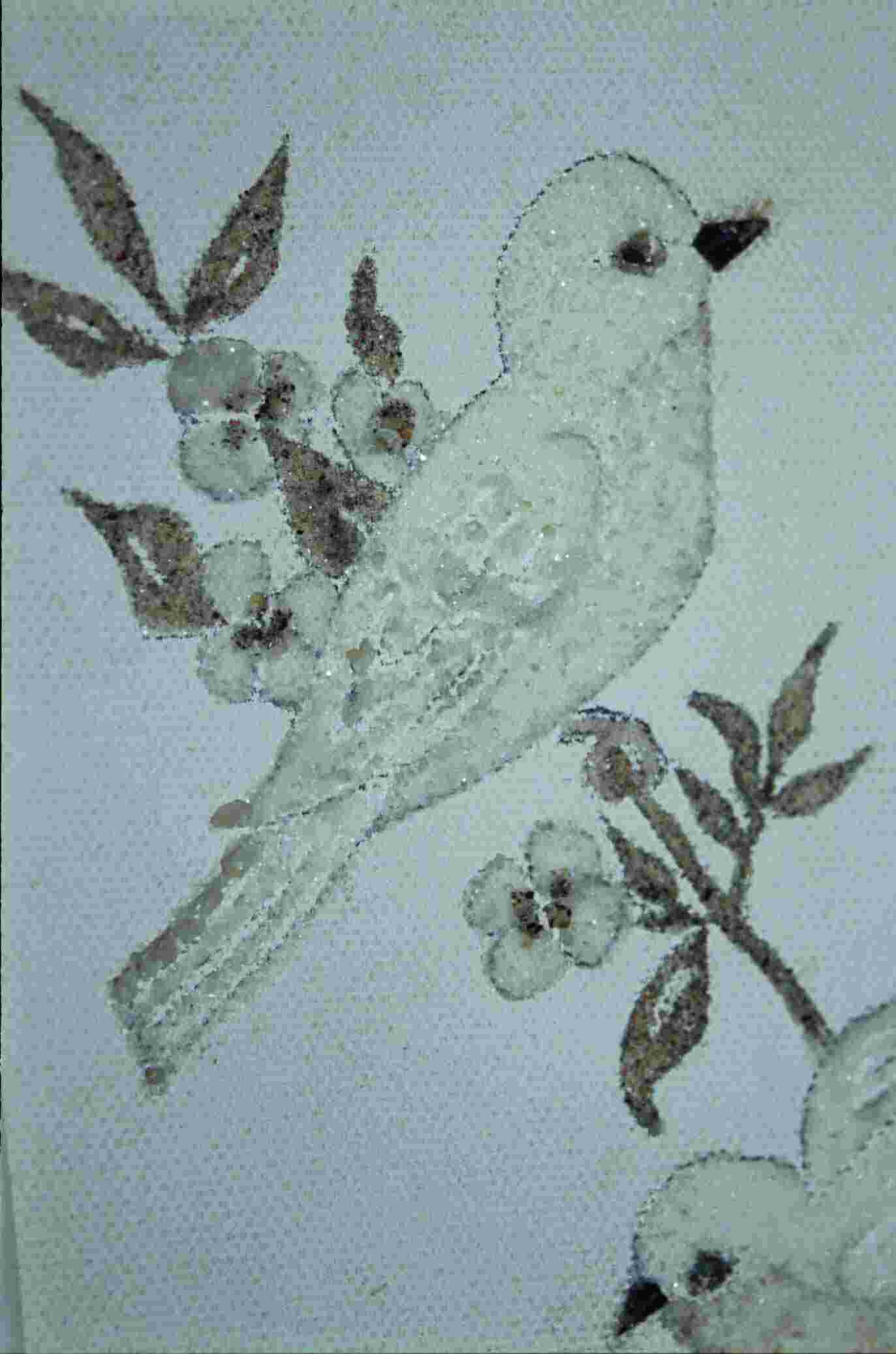
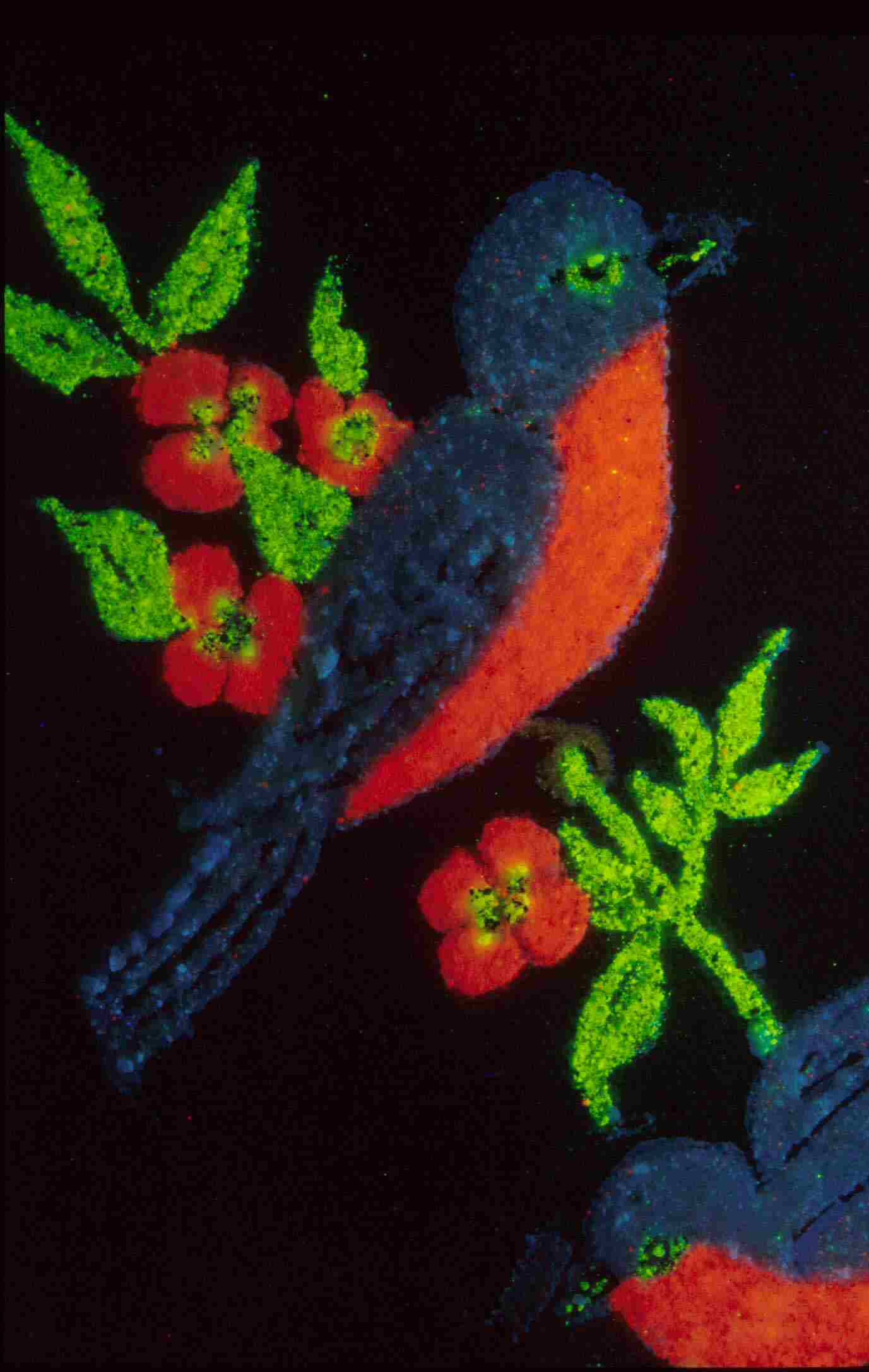
'Birds' - (detail)
Mrs. E. Phillips, 1950's - White light (left) /
Longwave and Shortwave U.V. lamps (right)
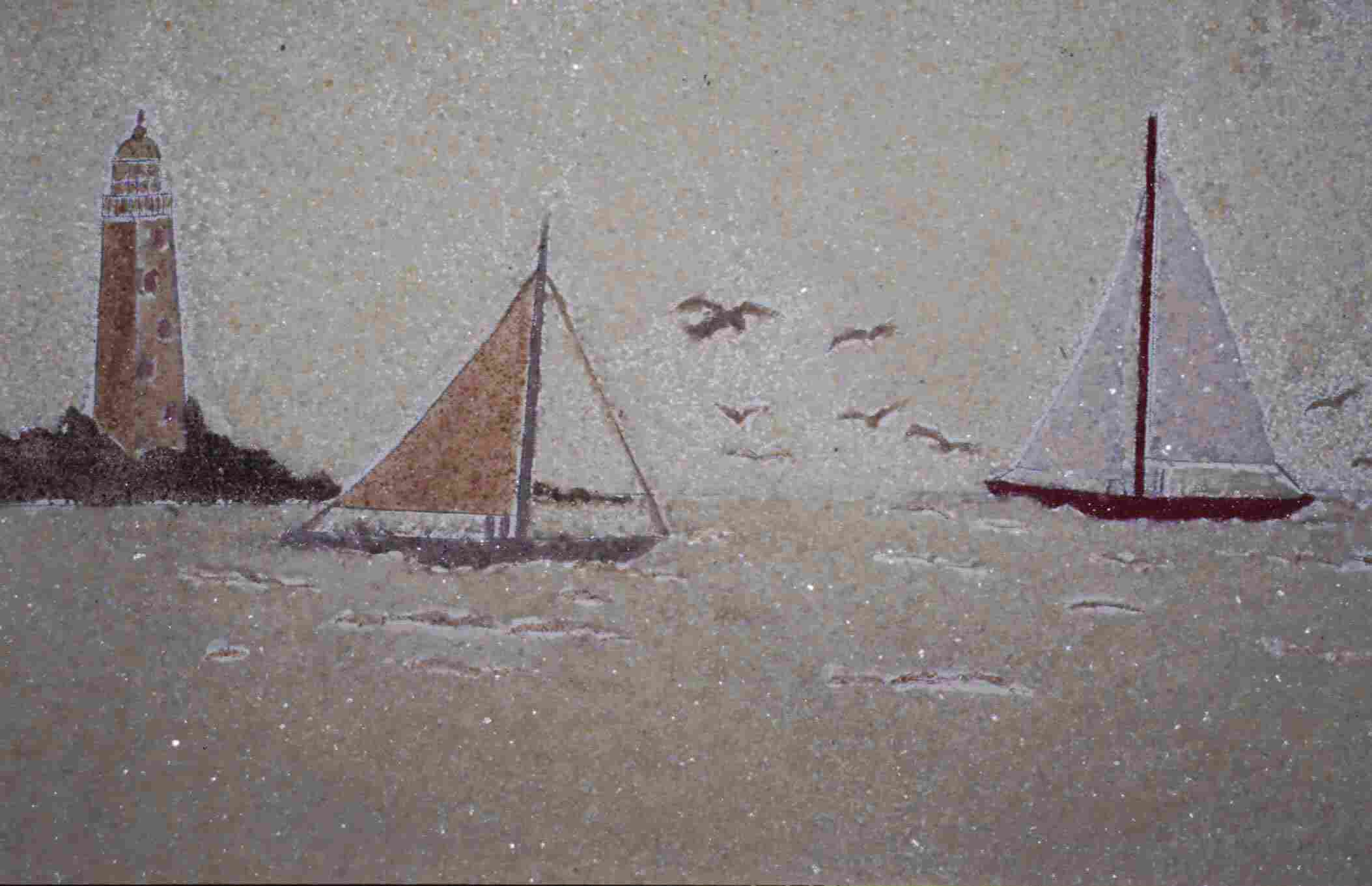

"Boats at Sea" -
(detail) Mrs. E. Phillips, 1950's - White light (left)
/ Longwave and Shortwave U.V. lamps (right)
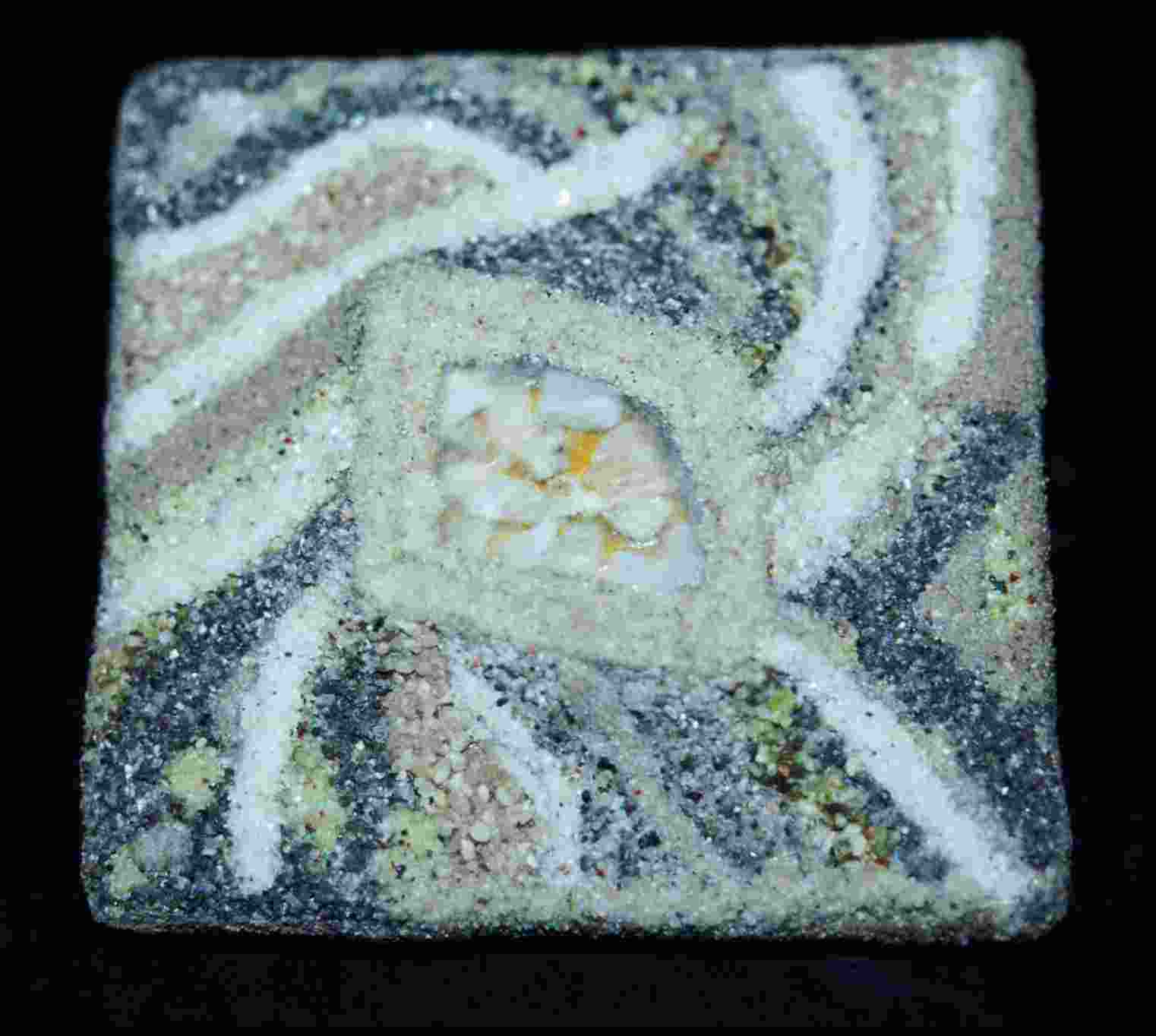
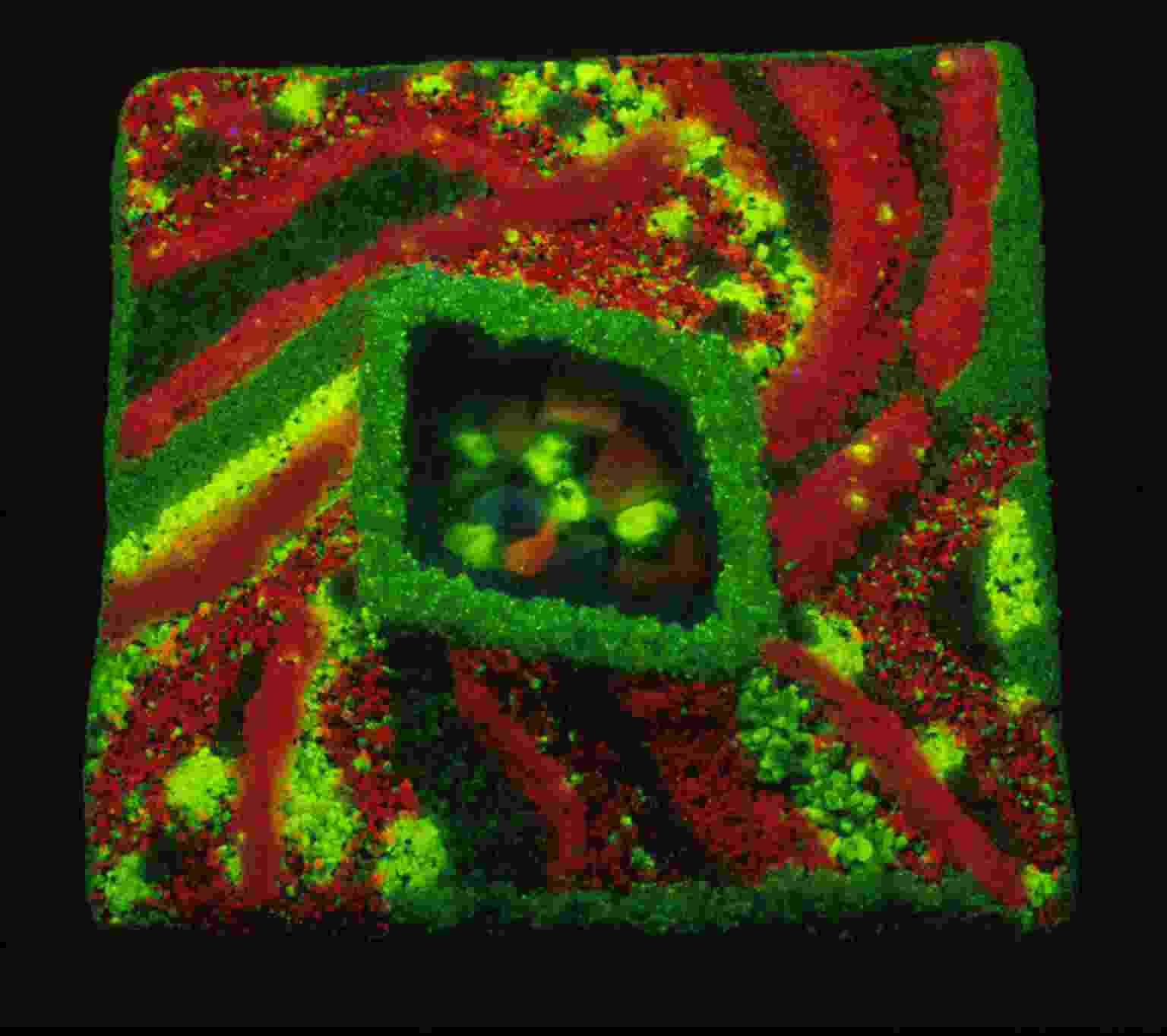
'Volcano' -
Miera, 1950's - White light (left) / Longwave and
Shortwave U.V. lamps (right)
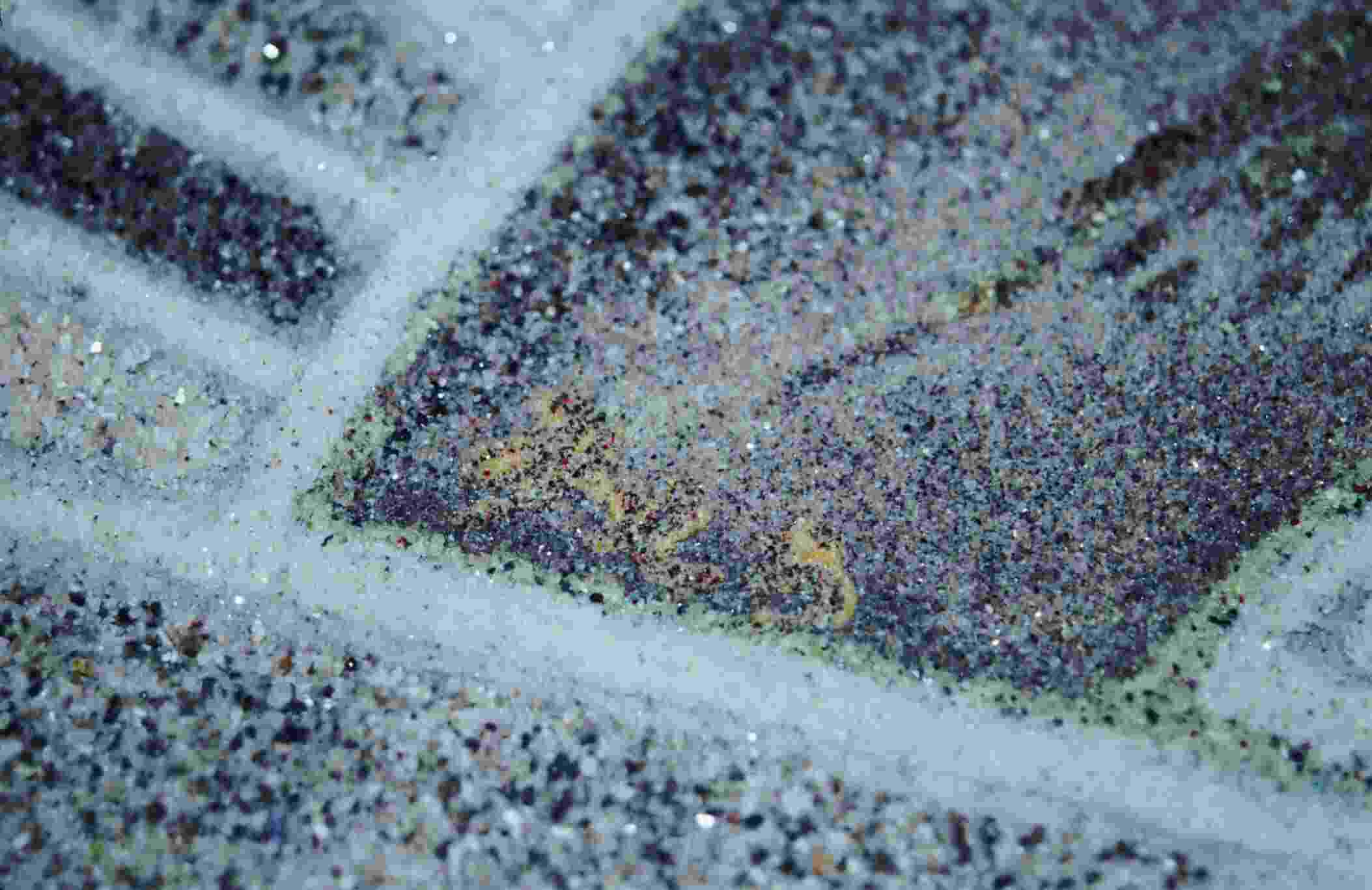

'Mt. Fuji' -
Miera, 1950's - close-up showing the amazing detail and Miera's
signature in Japanese script (center)
White light (left) /
Longwave and Shortwave U.V. lamps (right)